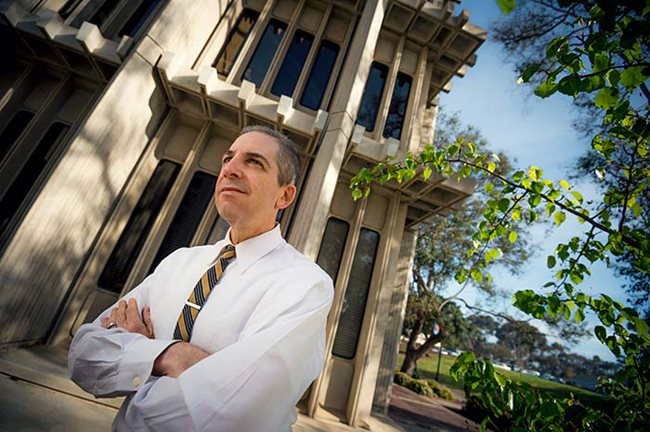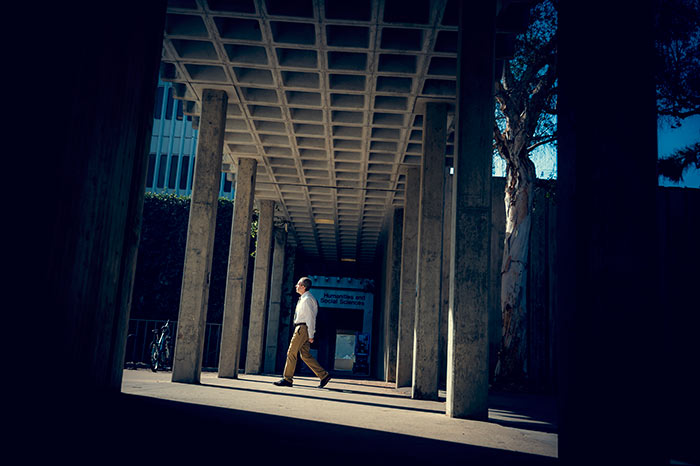
For Morgan Appel, director of the Education Department at UC San Diego Extension, the work he does is always informed by the fundamental traditions of research universities, which are based on the three pillars of research, service, and teaching.
While service and teaching are critical to his work, research plays a pivotal role because it informs the future.
“In everything we do, there is always a research question, whether it be process or content,” he said.
Appel, who has his bachelor’s and MBA from UC Irvine and done doctoral work at Claremont Graduate University’s School of Educational Studies, said the research he does on education is both theoretical and practical. Despite overseeing a department that serves more than 8,000 students annually, Appel said he still teaches about three to four courses per year.
“I do that to continue that connection and to keep my ear to the ground,” he said. “It’s easy for me to muse about theory in my office, but real insight into education requires me to be there and to interact with people who are doing the job.”
Through his hands-on teaching experience and research, Appel has written on everything from Common Core to gifted students to adult education to the importance of contextual learning.
In his constant surveying of the landscape, Appel said he sees five big trends shaping education in the 21st century that will have an impact on teachers and students. These trends are:
Education is being redefined.
Education is no longer the sole province of schools and universities. Increasingly, other institutions, including those in industry, are employing education’s best practices to provide training in the most effective and impactful way.
“We are redefining where education is happening,” Appel said. “We understand that education is not only lifelong, but happens everywhere.”
The knowledge economy of today requires that education moves beyond formal coursework to provide “just-in-time learning” through a variety of channels, including mentorships, he explained. Simply put, companies and trade organizations are looking for ways to offer new information and training in a time-efficient but fundamentally sound way.
“Adult learners come to us with a host of expertise and knowledge,” Appel said. “What they are looking for is the mortar between the bricks.”
Global demand grows.
The redefinition of education, coupled with a wave of retirements in the education profession, is increasing the demand for those who can teach and train.
This trend is particularly evident in the world of occupational training, where the pace of innovation requires workers to update their skills constantly. That, in turn, translates into a need for instructors or teachers who can provide this niche training on a timely basis. Appel stressed that this training is not necessarily about specialization, but instead is about skills integration.
“What we are looking for is not for generalists in the traditional sense, but people who can integrate and can take their knowledge and apply it to new situations,” he said.
Creativity makes a comeback.
Standardized tests are out and creativity is in when it comes to teaching, especially for K–12 teachers.
“In education, the pendulum swings, and it swings in very extreme ways,” Appel said. “For the last 25 years, the discipline was focused on standardization. The consequence of that was a sapping of creativity. It was a recipe that was very strict and that assumed everyone has the same pace and way of learning.”
He said this demand for creativity is coming from industries and universities that are looking for problem-solvers—not just those versed in rote memorization.
“It is not enough to paint by numbers. You must be able to paint a robust masterpiece,” Appel said.
Technology drives innovation and personalization.
Technology, such as online learning, is fundamentally changing education, Appel said. It is leading to increased personalization, allowing students to learn on their time and their terms. It is also fundamentally shifting the balance between formal and informal learning.
“Education is now more of a learning partnership,” Appel said.

But as the line between student and teacher blurs, there is greater need to ensure that all those involved in the learning process are critical consumers of information.
“We help students understand where they are getting their information and what they should deem a credible source,” he said. “How do you distinguish between CNN and Uncle Billy’s Blog? It might seem intuitive, but really it’s not.”
The need to see both the forest and trees.
Appel said there are common threads in education around the world, and so it is critical to know and understand the big picture on a global basis.
“Though contexts may be different, administrators and practitioners are compelled to contend with similar issues and phenomena worldwide,” Appel said. “That’s seeing the forest.”
On the other hand, he said, each learning experience needs to be understood in the unique context in which it operates. For instance, reading instruction is different when it is designed for K–12 students compared to adult learners at a community college.
“As we move forward, these one-size-fits-all programs are not going to work anymore,” Appel said. “That’s seeing the trees.”